Last Updated: April 2025
How to start an Amazon storefront in 2025 is a question many aspiring entrepreneurs are asking as they look to tap into the massive e-commerce market.
With over 300 million active users and 2.2 billion visits per month, Amazon stands as a highly profitable marketplace to begin your online business. Amazon’s vast customer base and robust infrastructure make setting up a storefront a lucrative venture.
This guide will walk you through the essential steps in Amazon storefront setup, helping you reach a global audience and grow your online business effectively.
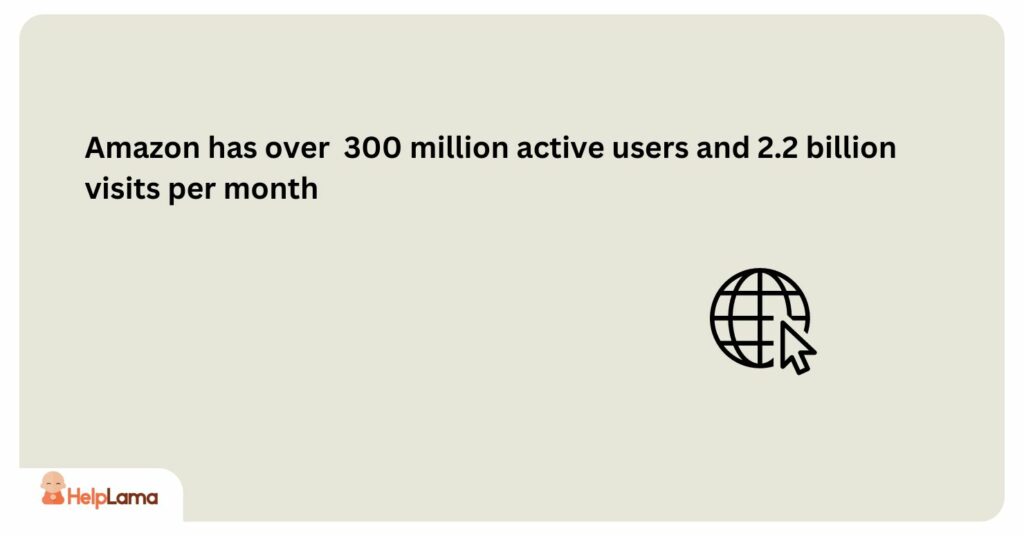
What is an Amazon storefront?
As a free self-service advertising platform, Amazon lets you create a dedicated storefront for your business. Globally, around 2 million small and medium-sized businesses are registered as sellers on Amazon.
By creating an Amazon Storefront, you can showcase your products and raise brand awareness via an easy-to-use interface that resembles an e-commerce website.

A multipage Amazon Store can be easily constructed using simple drag-and-drop tiles or pre-made themes. Additionally, you may personalize your store by uploading your own photographs, videos, and descriptions.
Requirements to create Amazon Storefront
The first step in setting up an Amazon storefront is to check if you qualify. You can begin by upgrading to a professional seller account and joining the Amazon business Registry (which requires you to have a trademark for your business).
A professional account comes with a monthly subscription, but the benefits considerably outweigh the costs when compared to individual account capabilities and overall cost/unit sold. There is also a cost associated with obtaining a trademark (typically between $250 and $750), but you will only have to pay that fee every ten years.
- Professional seller account: You need a professional seller account (rather than a free individual account), which any serious Amazon seller should already have.
- Brand registry: Previously, Stores were exclusively available to Amazon vendors. Any third-party seller who has registered with Amazon’s Brand Registry can now build an Amazon Store for free.
Benefits of Amazon Storefront
Below listed are the benefits of creating an Amazon store:
1) Dedicated Landing Page
Your Amazon Store makes customers aware of your business while displaying all of your products. Instead of having to look for each of your products separately, customers can browse your full product catalog in your store.

Whether it’s a link in your Instagram bio, a CTA on a TikTok ad, or an email blast to former customers, you’ll have a centralized location that’s strategically designed with Conversion Rate Optimization (CRO) throughout so that potential customers can easily find the products they’re most interested in within your store.
2) Zero Sponsored Ads
Sponsored advertising is a method used by most merchants to bypass their competition in the organic listings section of Amazon Search. This helps them to obtain immediate visibility for their chosen keywords.
Fortunately, competitors are not permitted to place advertisements on your Amazon storefront; your storefront is yours and yours alone.
3) Branding
Having an Amazon store is a great way to express your marketing creativity through complete customization with excellent photos, infographics, and even videos for your products.
Additionally, if you’re private labeling, it’s critical to establish a brand that people recognize and actively seek out your brand. For this, your storefront is the best place to clearly communicate a vision that resonates with your Ideal Customer Profile (ICP).

Find the top brands in the niche you wish to operate in and analyze their storefronts for ideas based on what they’ve identified as vital to their ICP.
4) Increased Visibility and Traffic
As your business grows, you’ll need a site to direct outside traffic to, and what better place than an Amazon shop? Moreover, with Amazon shop, you get access to Amazon Prime members and showcase your top products to a wider audience.
Additionally, you can reduce the friction for a consumer to transition from a passive viewer to an active buyer, allowing you to drive more impulse purchases. Not to mention that providing outside traffic to your storefront and product listings helps with Amazon SEO, which means that the more outside traffic that visits and converts, the higher your keyword rankings in Amazon search.
5) Showcase Products using Categories and Sub-categories
Suppose you have a large number of items and product kinds. In that case, it may be beneficial to nest them into several categories/sub-categories to improve the UX and make it easier for potential buyers to find the things they are most interested in.
Fortunately, you can do this through your Amazon storefront (seen below).
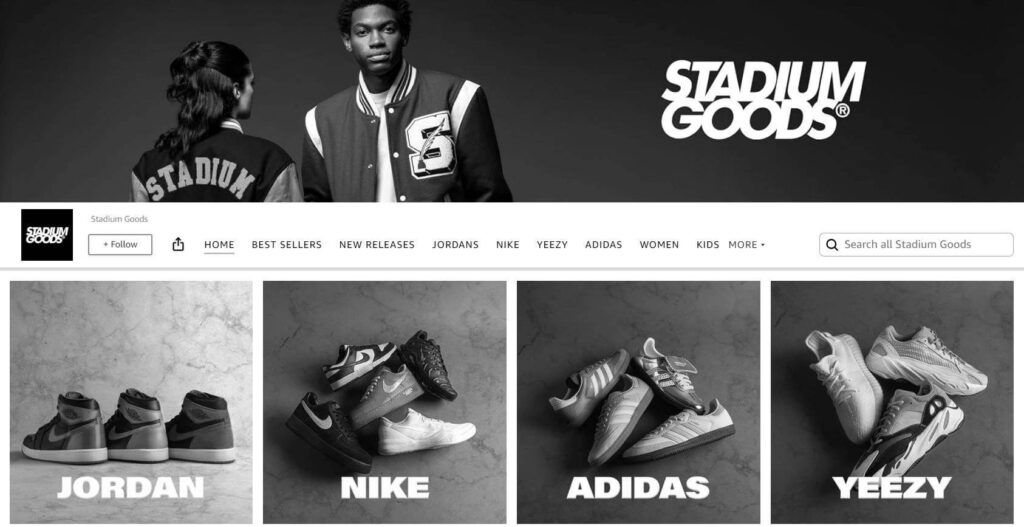
6) Get Insights
The dashboard allows you to see where your Store’s traffic is coming from, how well it is driving purchases, track page views, and more. These KPIs let you make informed decisions about how to sell your products and store.
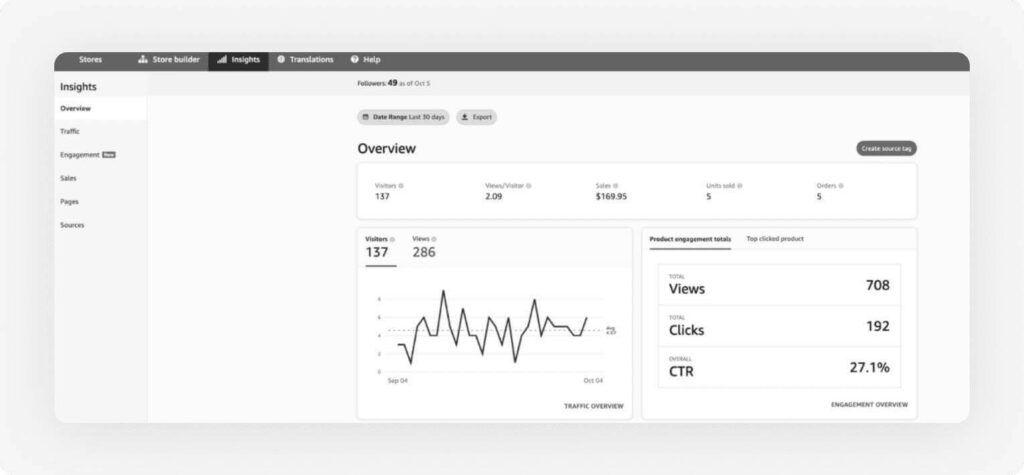
How To Start An Amazon Storefront: Step-by-Step Guide
This section covers every step for building an Amazon Store for your brand. You’ll need a professional seller account and Brand Registry enrollment to get started.
Create new images and infographics specifically for your Amazon Storefront to attract customers with fresh visual content. Always review Amazon’s creative guidelines for Stores.
Step 1: Set up your Store
In Seller Central, go to the “Stores” tab and click “Manage Stores.”

Click “Create Store” and select your brand (it must be enrolled in the Brand Registry).

In the Store builder, enter your brand display name and logo, then click “Next.”
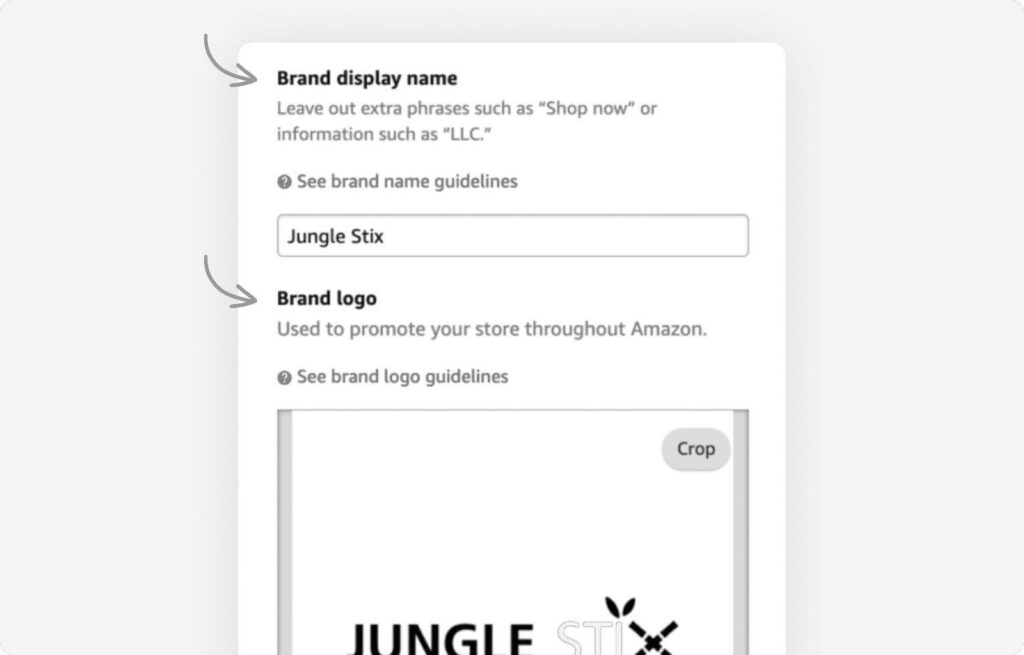
Step 2: Create a homepage
Now, let’s create your Store’s homepage, the first thing customers will see.
Choose from Amazon’s templates to tell your brand story, highlight a best-seller, or display products in a grid. You can also start with a blank page.
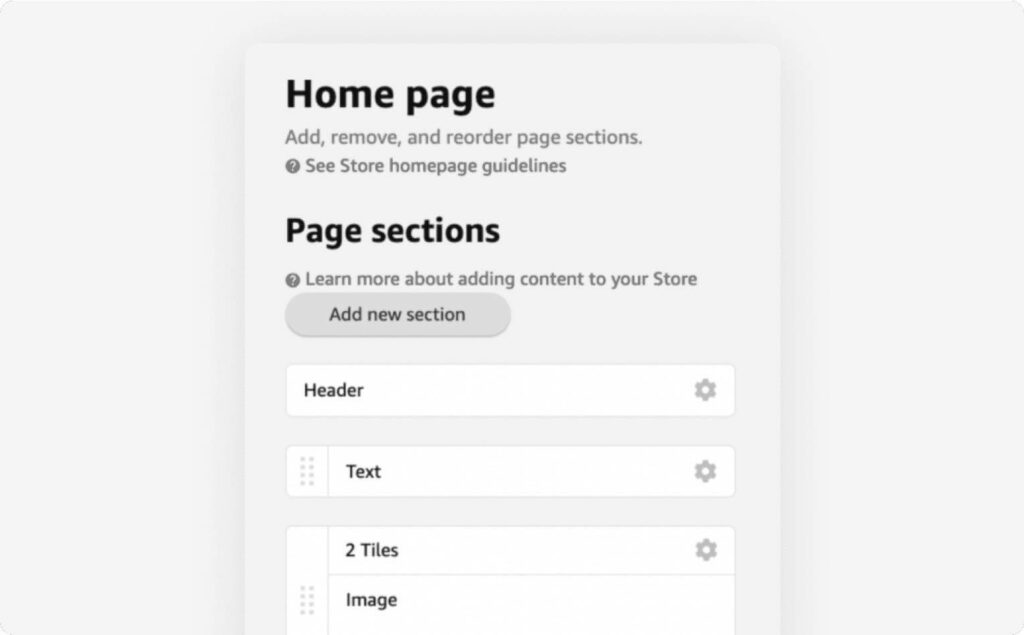
Enter a meta description for the homepage. This text helps your Store rank in Google searches and gives viewers a preview of your brand or products. Make it informative and catchy.
Step 3: Build your Store
Start building your Store by adding pages, sections, images, and product thumbnails. Use Amazon’s templates like product collection, product highlight, marquee, or start with a blank page.
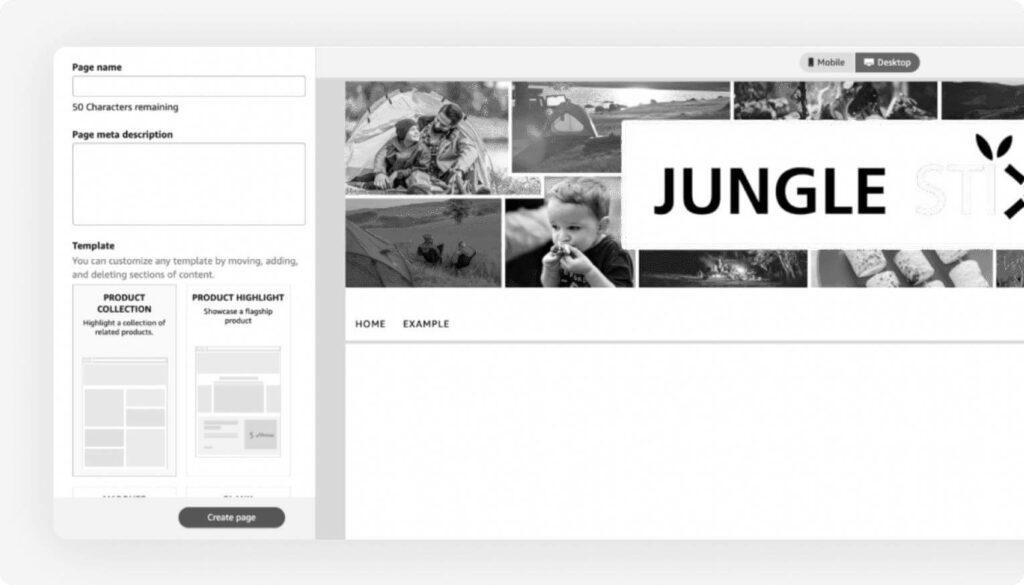
How to add new pages for each subcategory:
The “Home Page” is already set up by default. Now you need to create subcategory pages that customers can access from the home page.
On the left-hand side, click “add page.”
Enter the page title, and a description for the subcategory, and choose a template. For example, create a subcategory page called “Stainless Steel Roasting Sticks” using the “Product Collection” template to showcase these roasting sticks.
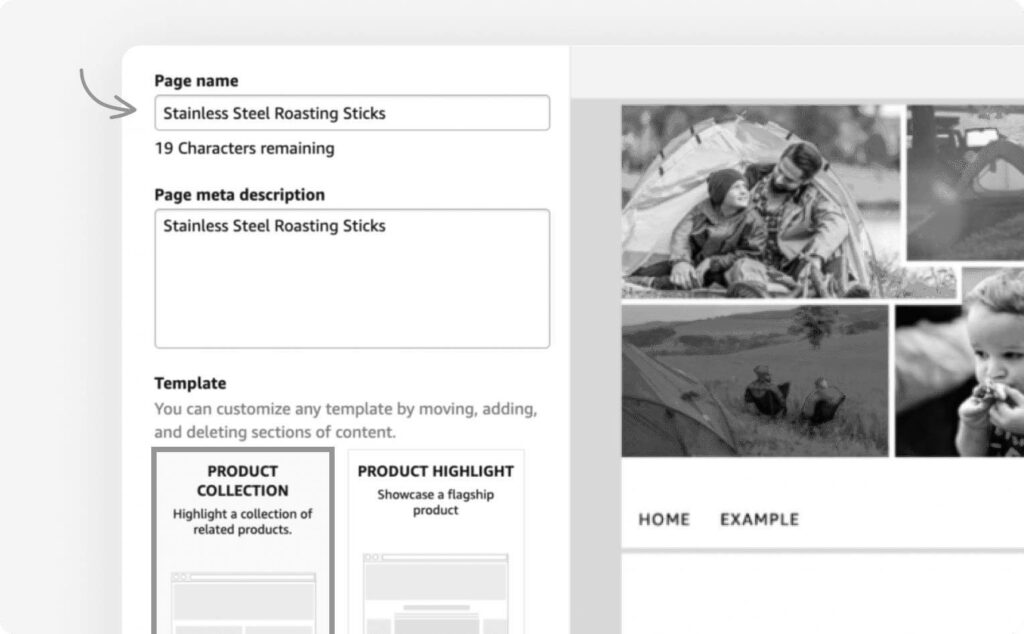
After you click “Create page,” your subpage will appear as a new tab on your Store homepage, as shown below:

You can add another subcategory to show how multiple subcategory tabs appear on the homepage.

Additionally, you can create a drop-down menu from the subpage’s tab to further categorize products within a subcategory. For this, click on the tab you want to customize on the left-hand side, then click “Add page” and enter the dropdown option.
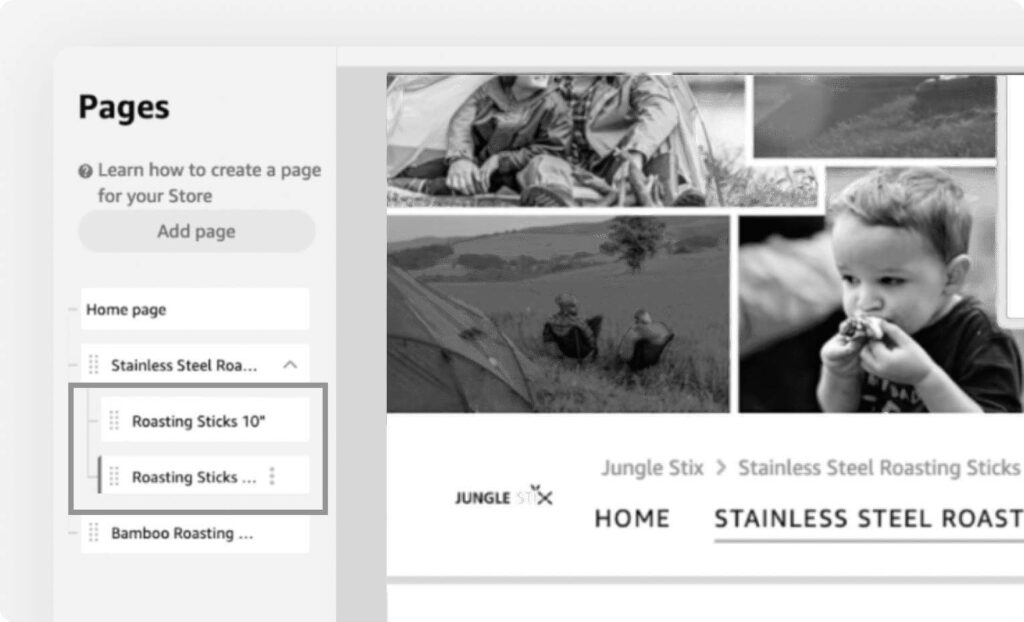
This is how it looks on the customer’s end:
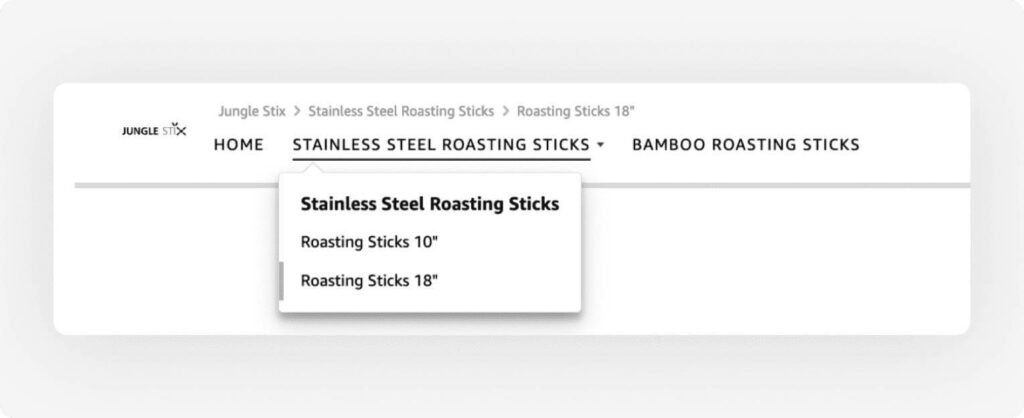
How to add a Header in your Amazon storefront?
The header is crucial for establishing your brand with a logo or branded image, making it clear to customers that they’re in your Store. Check Amazon’s creative guidelines for the correct dimensions before creating the banner. Amazon will also provide the required image size in the upload widget.

To upload a banner image, click on the header section at the top of your Store’s homepage, as shown above.

This is how it looks:

Step 4: Customization
Now, you’re ready to add new sections to your homepage and subpages. These sections can showcase product images, listing previews, videos, or text.
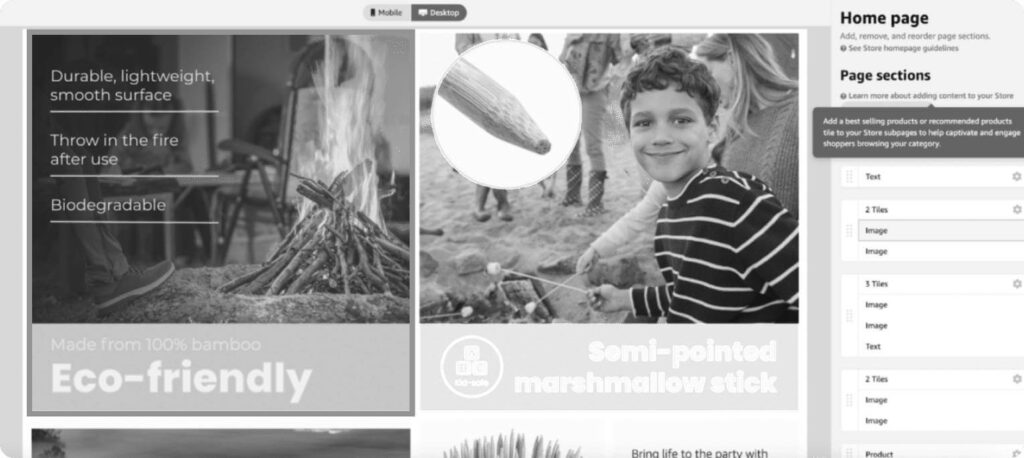
To add a new section, select one of the blank tiles on your homepage and choose your desired tile type.
Note: You can link image tiles to product listings, allowing customers to navigate to the pictured product by clicking on the image.

You can access multiple tile types for your store from Amazon.
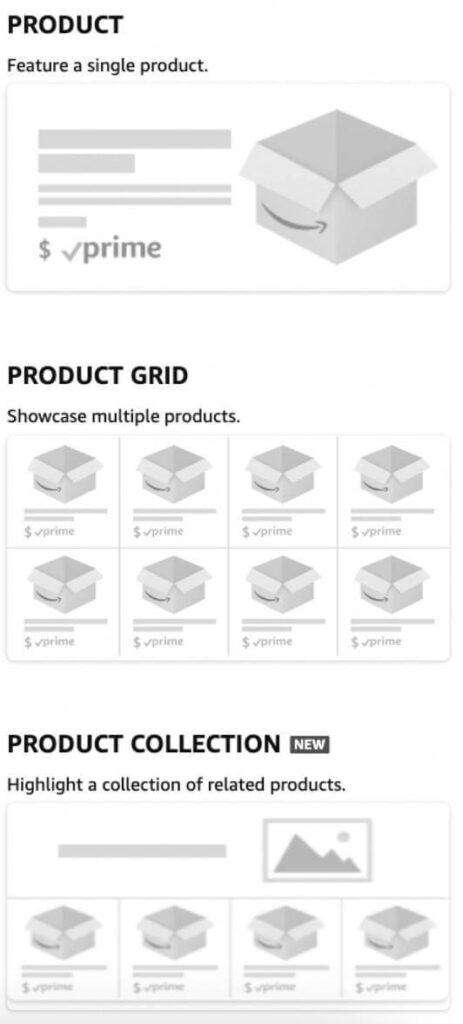
Keep in mind: Throughout the process of creating your Store, you can preview it on both desktop and mobile devices to gauge its progress.
Experiment with different tile options to find the best fit for your brand. You can rearrange sections by dragging and dropping the tiles. Here’s how the Jungle Stix Store is shaping up:
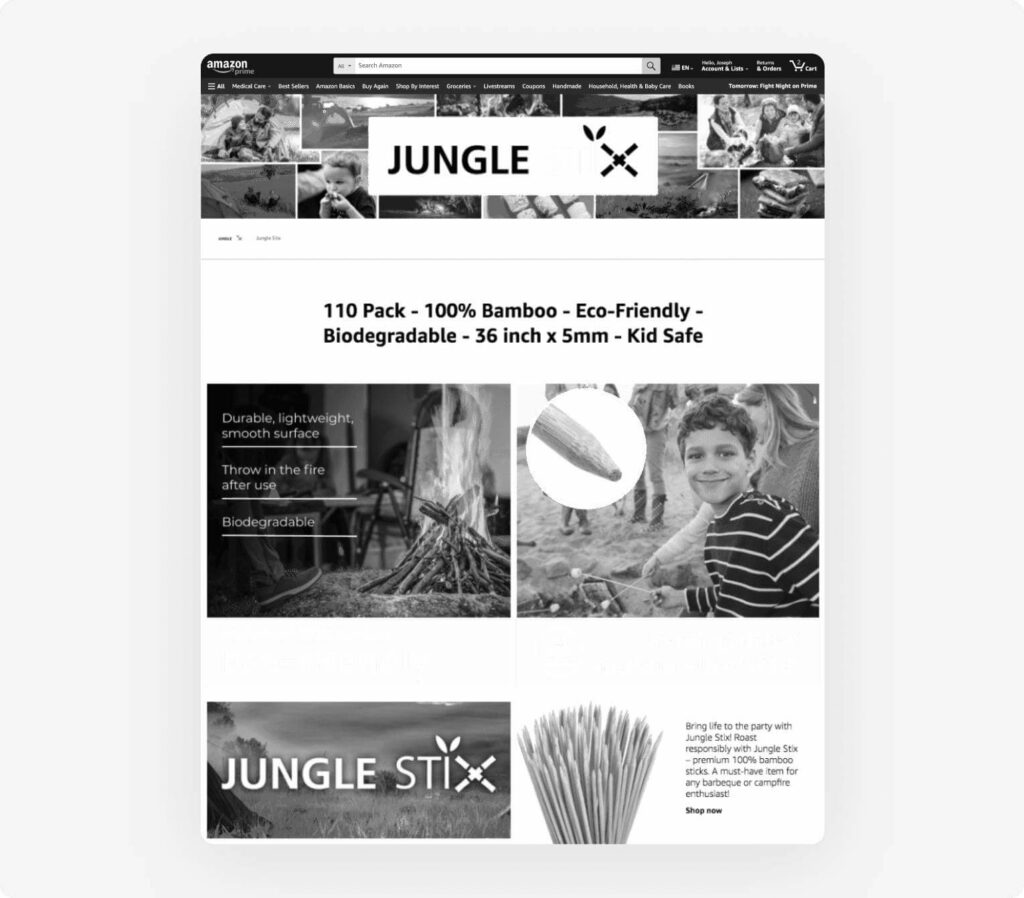
Showcasing your entire product line in your Store is an excellent way to highlight your latest offerings. Take the brand Better Boats, for example. They divide their homepage with a “product grid” and “video” tile below two lifestyle product images, each linking to the showcased product.
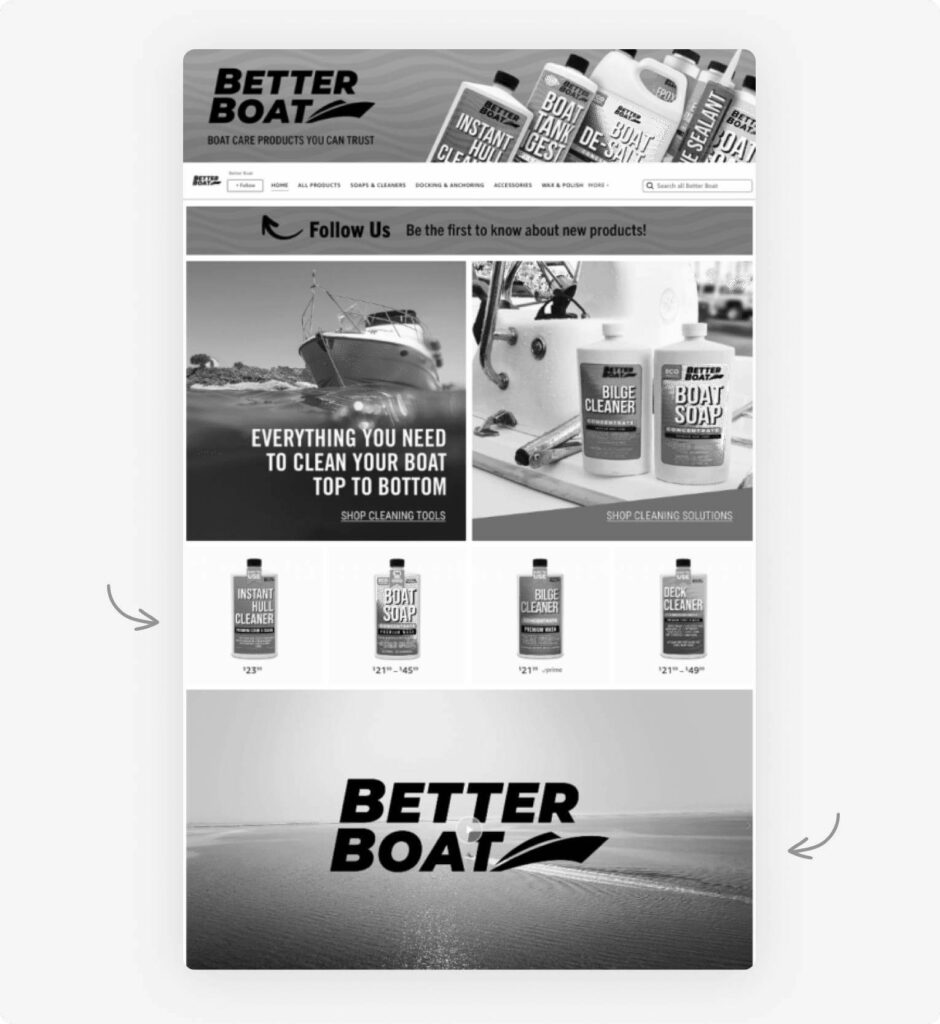
Let’s explore one of Better Boat’s subpages to see how they present each subcategory. Here, they utilize various tile types to feature the diverse products within this category. Customers can click on a thumbnail to view a product’s full listing.

Check out competitors’ Stores to gather insights on how they showcase their products and narrate their brand stories.
Step 5: Submit your Store for review
After completing your Amazon Storefront, click “Submit for publishing.” Amazon will review it within 24 hours. Once approved, your Store will be visible to customers on Amazon.
Creating a Store on Amazon is straightforward. Take time to experiment with the layout, adjusting sections and tile order to make your Store stand out.

Amazon Storefront Examples
Now that you know how to create an Amazon storefront, let’s take a look at some examples for inspiration.
1) Kleenex
Kleenex has preceded the brand display with its emblem and motto, as well as its products. As soon as a customer enters their storefront, they get a good sense of the branding. We entered their storefront with a good sense of their branding.

2) Bissell’s
Bissell’s Amazon storefront offers a cleaning solution for any surface in your home. They offer a variety of products but to avoid overwhelming the customers with their vast catalog, their store is organized on the basis of surface type.
Such a well-organized store enables the customers to navigate through the products and find what they need easily, improving customer experience.

3) Beats
Beats storefront design uses a module with a lifestyle image that clearly expresses your brand’s message. In this situation, Beats’ entire brand messaging is centered on providing their customers with premium sound enjoyment.

Here, this image perfectly embodies that messaging; whether you’re outside or going about your regular life, you’ll get premium and uninterrupted high audio quality. They’ve supplemented the messaging with some icons and text to effectively highlight their unique selling points to their customers.
4) Tide
If you sell everyday necessities or things that may need to be refilled throughout the year, this is an excellent example. Tide has grouped all of the products that customers often purchase using the subscribe and save (SNS) model into a single category.

This not only provides purchasers with simple access to the goods they wish to purchase via SNS, but it also provides them with ideas for things to refill or subscribe to the SNS model for.
5) Apple
Apple too, sells a wide range of products with numerous possibilities within each category. Instead of requiring their customers to look for products separately among a sea of product descriptions and photographs, they have made it easier by categorizing each gadget.

So that was our detailed guide on how to create an Amazon storefront with examples. Now, let’s explore how you can provide top-notch customer service with Helplama!
Meet Helplama – Your Dedicated Partner For Customer Service!
Helplama offers customized customer support solutions specifically designed for businesses, prioritizing live chat, email, and voice assistance provided by a network of skilled agents in the United States.

Key Features
- Expert US-based Agents: Helplama boasts a team of proficient agents based in the US, trained to handle live chat, email, and voice support with precision.
- Multichannel Support: Enjoy seamless customer service across various channels, ensuring accessibility and convenience for your customers.
- Tailored Assistance: Helplama provides personalized assistance tailored to address the unique needs and concerns of your business and customers.
- 24/7 Availability: With Helplama, round-the-clock support is guaranteed, ensuring prompt assistance whenever your customers need it.
- State-of-the-Art Technology: Helplama utilizes cutting-edge tools and technologies to ensure efficient and effective customer interactions.
- Scalable Solutions: Helplama offers scalable solutions that adapt to your business’s evolving requirements, ensuring consistent quality service.
Conclusion
In this guide, we’ve explored the essential steps on How to Start an Amazon Storefront in 2025. By following these steps diligently, entrepreneurs can lay a solid foundation for their online business venture.
Remember, almost 45% of Amazon sellers generated $1000 to $25000 monthly, showcasing the earning potential of the platform. With dedication and strategic implementation, aspiring entrepreneurs can unlock the vast potential of the Amazon marketplace and embark on a rewarding journey of digital entrepreneurship.
Additionally, we recommend using Helplama’s outsourced customer service for enhanced customer experience and building brand loyalty.
So what are you waiting for? Sign up now to get a quote!


